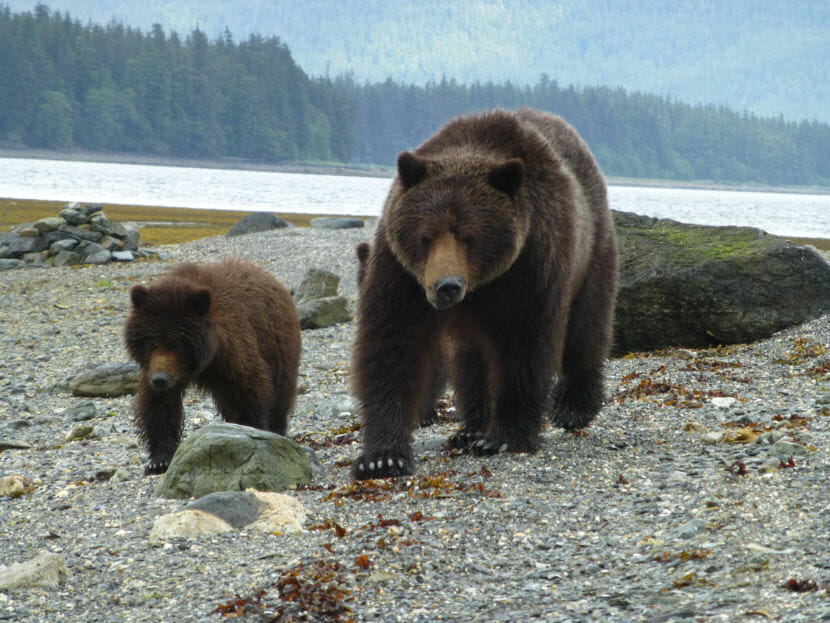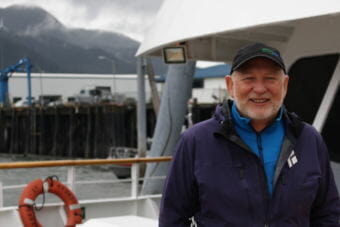
Small luxury cruises in Southeast Alaska offer guests a chance to explore remote spots in the Tongass National Forest. Passengers get a front row seat to look for wildlife. But there’s another kind of tourism happening at the same time: big game hunting. That can be a problem when the two interests overlap.
Now, two seemingly different groups are trying to find a solution.
The Safari Endeavour was designed to give guests the experience of adventure with the comfort of sleeping in high-end sheets. On this ship, you can wake up to locally sourced food, and spend the afternoon paddling to a distant cove.
Those perks are available to a small passenger list of up to 70 people.
CEO and owner of UnCruise Adventures, Captain Dan Blanchard, shows off favorite place on the boat to take in the scenery roll out a yoga mat, or even spot a bear from the deck.
That’s a big part of what Blanchard said UnCruise is all about: being able to view wildlife in this pristine environment.
“Southeast Alaska is a bastion for wilderness — not just for Alaska but for our world,” he said.
The trips have become so popular the company has even made a push for an earlier start season. Of course, this Safari Endeavour is a hunt for the eyes. But last year, on a different UnCruise boat, the hunt became real.

As guests peered through binoculars at a bear, they saw a hunter shoot it.
“My reaction was it’s bound to happen,” said hunting guide Thor Stacey. He’s been guiding in Alaska for decades. To be clear, it was a local hunter — not a guide — who shot the bear as a boat of surprised tourists watched. But Stacey said generally nobody, including hunters, wants to see that happen.
Still, he thinks as more small cruises expand into the spring and fall, the conflict seems inevitable. That’s traditionally the bear hunting season. A time when as many as 20 guides lead clients around the region.
Stacey said that’s led to frustrations for both small cruise ships and hunting guides alike.
He’s heard the complaint: ‘There’s all this country out there? Why can’t we just go where we want in the spring,’ and we’re sitting there saying we’re already here … and our use has been here since the 1930s.”
The Tongass is huge. But small cruises and big game guides can’t just go anywhere. They have to obtain special use permits from the U.S. Forest Service. That becomes a problem when the two ventures overlap. For bear hunters, the scent of an entire boat of people can throw off the animal’s behavior.
Stacey said hunting guides attracted some of the original adventure tourists to the region. As the small cruise industry expands, he said the game guides are the ones who feel “threatened.”
“In America, the bigger you are the better things generally work out for you … So when you see a large economic interest like that show up and you’re a group of small business. The fear of being pushed out or being pushed aside is very intense.”
Add to that, Stacey said, the misconceptions people have about big game hunting. He stresses this is a regulated industry. He’s concerned about the sustainability of the bear population and keeping the Tongass wild just as much as anyone else.
So, after word got around about the bear shooting by the local hunter, Stacey said it was time for a conversation with the small ships.
“We figured if we helped them out, the outcome would be much better,” he said.
Blanchard said he began to understand what it means to harvest a bear and how the hunts are controlled.
“That quite frankly, even though I’m not a bear hunter, it put me at more comfort,” he said.
In January, the two groups got together — in meetings moderated by the forest service — to hatch a plan. Hunting guides shared their knowledge and made suggestions on alternative spots for the small cruise ships to explore. There’s now a voluntary schedule where the businesses can keep tabs on each other to avoid being in the same place at the same time.
Blanchard acknowledges this new agreement, so far, has been a challenge.
“It’s not a lot of places and probably when we go back we’ll need to try to charter new spots for the small ships next spring,” he said.
But Blanchard thinks there’s still room for different types of tourism to coexist in the Tongass.
